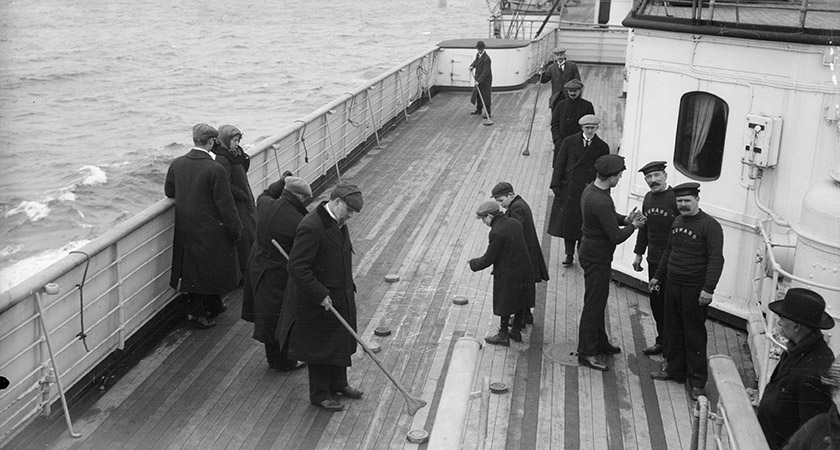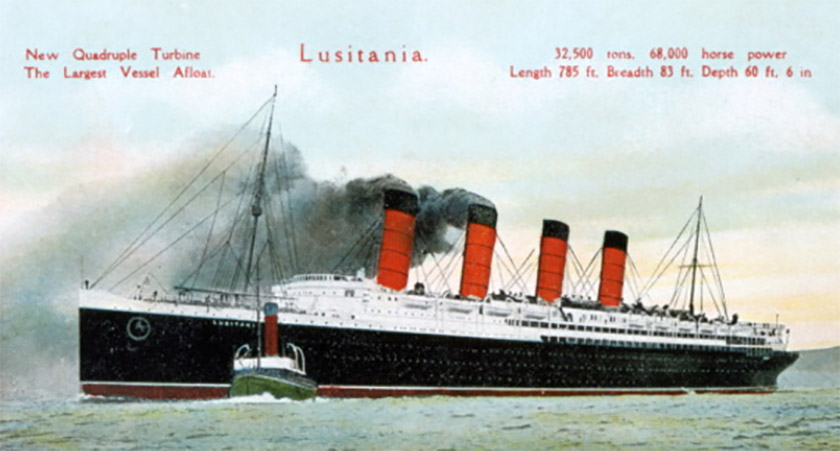OVER one thousand people died when the RMS Lusitania was torpedoed off the Old Head of Kinsale in Co. Cork on May 7, 1915.
The British ocean liner, which was once the world’s biggest ever passenger ship, was sunk by a German submarine as it came towards the end of its voyage from New York to Liverpool during World War I.
More than one hundred Irish people died in the tragedy, which turned public opinion around the world against Germany and led to a surge of Irish recruits signing up to fight for the British Army.
Here’s 13 interesting facts about the Irish tragedy that was the Lusitania disaster:
1. The Lusitania was the largest ship in the world
At the time of its completion in 1906, the Lusitania was the largest passenger ship on Earth at 240 metres long.
It held that record until the arrival of its running mate RMS Mauretania in November that year – which was just one metre longer. For comparison, the infamous RMS Titanic was almost 270 metres from front to back.
The Lusitania mostly carried passengers across the Atlantic Ocean between Britain and the United States – but when World War I began in 1914, it fatefully began to carry ammunition as well.
2. The ship was repainted in camouflage
At the outbreak of war in 1914, the Lusitania was repainted with a grey colour scheme in attempt to make her more difficult to detect by German U-boats.
Despite the threat from submarines, the ship continued to carry thousands of passengers back and forth across the Atlantic while demand remained high.
Before the Lusitania was torpedoed, submarine attacks had been relatively rare and so the ship’s camouflage was dropped and she was repainted to civilian colours.
3. The sea around Ireland was a war zone
Germany introduced unrestricted submarine warfare in February 1915, just three months before the disaster.
In doing so, the Germans declared the seas around Britain and Ireland a war zone and said they would attack any Allied ship that entered the region
This was in retaliation for a British naval blockade that had blocked German ships from access to the English Channel and the North Sea.
4. The Germans warned passengers not to board
The German Embassy in Washington printed an ominous warning to travellers in 50 American newspapers on April 22, 1915 – nine days before the Lusitania set off.
The message read: “NOTICE! TRAVELLERS intending to embark on the Atlantic voyage are reminded that a state of war exists between Germany and her allies and Great Britain and her allies; that the zone of war includes the waters adjacent to the British Isles.
“In accordance with formal notice given by the Imperial German Government, vessels flying the flag of Great Britain, or any of her allies, are liable to destruction in those waters and that travellers sailing in the war zone on the ships of Great Britain or her allies do so at their own risk.”
5. The ship departed anyway
 Saloon passengers enjoy a game of shuffleboard on the Lusitania. Picture: Topical Press Agency/Getty
Saloon passengers enjoy a game of shuffleboard on the Lusitania. Picture: Topical Press Agency/GettyDespite the German warning, the Lusitania departed from New York on May 1, 1915 on its way to Liverpool.
It seems that many people didn't really believe that the Germans would attack a luxury cruise ship with 1,959 people on board – especially with 159 neutral Americans passengers on board.
The average crossing time was just over a week. On the morning of May 7, 1915, the liner was just 11 miles off the coast of Co. Cork on its final approach towards Liverpool.
6. The Titanic disaster was recent history
The third anniversary of the infamous Titanic sinking, which killed 1,517 people, had passed just a fortnight previously on April 14.
As in the sinking of Titanic, most of the casualties of the Lusitania disaster were from drowning or hypothermia, and not from the explosion caused by the German torpedo.
The Lusitania wreck sits at a depth of just 93 metres, compared to the Titanic’s resting depth of over 3,700 metres out in the mid-Atlantic.
7. The Lusitania sank in 18 minutes
On May 7, 1915 the Lusitania was approaching the coast of Cork. The voyage was almost over, but it had reached its most dangerous point due to German submarines.
It was quickly spotted by the German U-boat U-20 which landed a direct hit on the side of the ship, causing a huge explosion.
The ship immediately began to sink. Captain William Turner ordered that the ship head for the Irish coast, but it was too late. Of the 1,959 people on board, only 761 survived and 1,198 were killed.
8. It was a tragedy for Ireland
Dozens of Irish people making their way home via Liverpool were among the dead.
According to Irish journalist Senan Malony, who wrote Lusitania: An Irish Tragedy, 140 Irish people died when the ship went down, 70 of them passengers and 70 crew.
Among them were James McDermott, the ship’s surgeon, from Co. Cork, his assistant, Dr Joseph Garry, from Co. Clare, the composer Thomas O’Brien Butler and renowned Irish art dealer Hugh Lane.
9. Irish fisherman raced to the rescue
After the explosion, local fisherman from Cobh, Kinsale and Courtmacsherry began a huge rescue effort.
Without the efforts of locals – who risked their own lives – the official death toll of 1,198 could have been far worse.
Dozens of the dead were brought ashore in Cork where they were put in open coffins for identification. Many of those who perished in the disaster were never identified as their next of kin had also drowned.
10. Germany said it was justified
The Germans claimed that sinking the Lusitania was justified in a war zone because its cargo included ammunition and shell casings to be used by the British in the Great War.
The Cunard Line, who operated the Lusitania, denied the charge in The New York Times on May 10, 1915:
“The United States authorities would not permit us to carry ammunition, classified as such by the military authorities, on a passenger liner,” they said.
11. Britain quickly exploited the tragedy
The British Government was quick to exploit the tragedy for the war effort, using the deaths of the passengers as a rallying call.
This was especially the case in Ireland, where recruitment was slow.
One poster appealing to young Irishmen in Dublin read: “Irishmen, Avenge the Lusitania!”
12. The wreck is in a bad way
102 years after the Lusitania sank, its wreck off the coast of southern Ireland is in danger of a complete collapse.
The wreck lies on its starboard side 11 miles south of the lighthouse at Kinsale, 91 metres beneath the waves.
Expeditions to the ship have shown that the ship has deteriorated much faster than Titanic has.
The Lusitania appears in a much more deteriorated state due to the presence of fishing nets lying on the wreckage, the blasting of the wreck with depth charges and multiple salvage operations.
13. It’s still remembered in Ireland today
The 100th anniversary of the sinking in 2015 was commemorated across Ireland, and special stamps were issued by An Post to remember the victims.
In 2017, a memorial garden complete with a 20-metre long bronze sculpture was unveiled in Cork to honour the victims the disaster.
The bronze sculpture entitled 'The Wave', by Irish artists Liam Lavery and Eithne Ring, explains the tragic story of the great liner on its fateful last journey.










